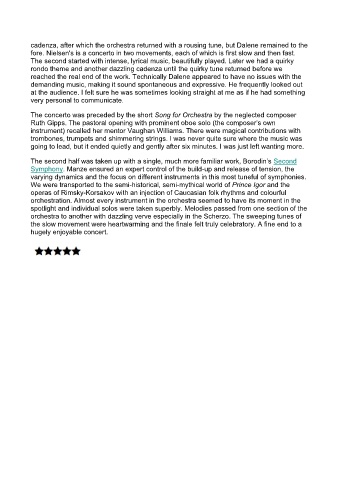Page 250 - Royal Liverpool Philharmonic Coverage Book 2023-24
P. 250
cadenza, after which the orchestra returned with a rousing tune, but Dalene remained to the
fore. Nielsen's is a concerto in two movements, each of which is first slow and then fast.
The second started with intense, lyrical music, beautifully played. Later we had a quirky
rondo theme and another dazzling cadenza until the quirky tune returned before we
reached the real end of the work. Technically Dalene appeared to have no issues with the
demanding music, making it sound spontaneous and expressive. He frequently looked out
at the audience. I felt sure he was sometimes looking straight at me as if he had something
very personal to communicate.
The concerto was preceded by the short Song for Orchestra by the neglected composer
Ruth Gipps. The pastoral opening with prominent oboe solo (the composer’s own
instrument) recalled her mentor Vaughan Williams. There were magical contributions with
trombones, trumpets and shimmering strings. I was never quite sure where the music was
going to lead, but it ended quietly and gently after six minutes. I was just left wanting more.
The second half was taken up with a single, much more familiar work, Borodin’s Second
Symphony. Manze ensured an expert control of the build-up and release of tension, the
varying dynamics and the focus on different instruments in this most tuneful of symphonies.
We were transported to the semi-historical, semi-mythical world of Prince Igor and the
operas of Rimsky-Korsakov with an injection of Caucasian folk rhythms and colourful
orchestration. Almost every instrument in the orchestra seemed to have its moment in the
spotlight and individual solos were taken superbly. Melodies passed from one section of the
orchestra to another with dazzling verve especially in the Scherzo. The sweeping tunes of
the slow movement were heartwarming and the finale felt truly celebratory. A fine end to a
hugely enjoyable concert.

